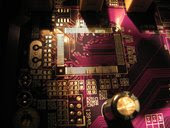First programmable computer
The Z1 originally created by Germany's Konrad Zuse in his parents living room in 1936 to 1938 is considered to be the first electrical binary programmable computer
The first digital computer
Short for Atanasoff-Berry Computer, the ABC started being developed by Professor John Vincent Atanasoff and graduate student Cliff Berry in 1937 and continued to be developed until 1942 at the Iowa State College (now Iowa State University). On October 19, 1973, US Federal Judge Earl R. Larson signed his decision that the ENIAC patent by Eckert and Mauchly was invalid and named Atanasoff the inventor of the electronic digital computer.
The ENIAC was invented by J. Presper Eckert and John Mauchly at the University of Pennsylvania and began construction in 1943 and was not completed until 1946. It occupied about 1,800 square feet and used about 18,000 vacuum tubes, weighing almost 50 tons. Although the Judge ruled that the ABC computer was the first digital computer many still consider the ENIAC to be the first digital computer.
Because of the Judge ruling and because the case was never appealed like most we consider the ABC to be the first digital computer. However, because the ABC was never fully functional we consider the first functional digital computer to be the ENIAC.
The first stored program computer
The early British computer known as the EDSAC is considered to be the first stored program electronic computer. The computer performed its first calculation on May 6, 1949 and was the computer that ran the first graphical computer game
The first personal computer
In 1975 Ed Roberts coined the term personal computer when he introduced the Altair 8800. Although the first personal computer is considered to be the Kenback-1, which was first introduced for $750 in 1971. The computer relied on a series of switches for inputting data and output data by turning on and off a series of lights.
The Micral is considered the be the first commercial non-assembly computer. The computer used the Intel 8008 processor and sold for $1,750 in 1973.
The first workstation
Although never sold the first workstation is considered to be the Xerox Alto, introduced in 1974. The computer was revolutionary for its time and included a fully functional computer, display, and mouse. The computer operated like many computers today utilizing windows, menus and icons as an interface to its operating system.
The first PC (IBM compatible) computer
In 1953 IBM shipped its first electric computer, the 701. Later IBM introduced its first personal computer called the "IBM PC" in 1981. The computer was code named and still sometimes referred to as the "Acorn" and had a 8088 processor, 16 KB of memory, which was expandable to 256 and utilizing MS-DOS.
The first PC clone
The first PC clone was developed by Compaq, the "Compaq Portable" was release in March 1983 and was 100% compatible with IBM computers and software that ran on IBM computers.
Saturday, April 18, 2009
Subscribe to:
Post Comments (Atom)





No comments:
Post a Comment